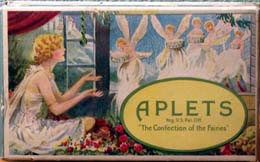On February 23, 1921, a new confection called Aplets is advertised in The Seattle Times. Brothers-in-law Mark Balaban (ca. 1881-1957) and Armen Tertsagian (1881-1953) produce the candy, which is primarily composed of apples, honey, and walnuts, using fruit from their Liberty Orchards farm in Cashmere, a small Chelan County town on the Wenatchee River in North Central Washington. Marketed throughout the Pacific Northwest using the slogan "The Confection of the Fairies," Aplets are an immediate success. Liberty Orchards will introduce Cotlets, a similar candy made from apricots and walnuts, a few years later, and Aplets & Cotlets will become and remain a popular gift item and tasty ambassador for Washington's fruit industry.
New Beginnings, New Businesses
Armen Logofet Tertsagian arrived in Seattle from his native Armenia in 1906. During his first years in Seattle, while building his business career, Tertsagian lived at the downtown Seattle YMCA. His first business venture was an Oriental rug dealership, Armen & Emmanuel, opened in partnership with J. M. Emmanuel at 1118 Third Avenue.
Mark (Marcar) Sarkis Balaban was born in Turkey and came to Seattle around 1913. By 1914, Tertsagian and Balaban were operating the Elzem Company, a dairy business whose primary product was yogurt, a product then virtually unknown to most American consumers. The business eventually failed. In 1914, Mark's younger sister Elizabeth Balaban (1886-1944) joined her brother in Seattle. Elizabeth went on to marry Armen Tertsagian, making the close friends brothers-in-law.
Turkish Delight
Aplets & Cotlets are closely related to the confection known as Turkish Delight. Turkish Delight is also called locum rahat (some sources say "rahat locum," or use the spelling "locoum" or "lokum"), and has been enjoyed for hundreds of years. Traditional recipes for Turkish Delight involve mixing honey or sugar syrup with cornflour starch, flavoring such as juice or flower essences, and sometimes nuts. The resulting candy is then cut into cubes and dusted with an agent to prevent sticking, such as powdered sugar.
The 2002 book Sweets: A History of Candy says: "Locum rahat means 'throat's ease' in Turkish, and it was most likely invented by Arab apothecaries some time around the ninth century, as a species of lohoch, a gummy, slowly melting medical preparation prescribed for sore throats and other ailments ... Turkish Delight is made all over the Middle East, Russia, and the Balkans, and it is hugely popular in Greece" (Richardson, 38). Turkish Delight (called "lumps of delight") features in Charles Dickens's final novel, The Mystery of Edwin Drood (1870), and in C. S. Lewis's The Lion, the Witch, and the Wardrobe (1950), where the wicked White Queen character uses the candy to enchant the young Edmund Pevensie.
An Apple a Day
In 1915, Balaban and the Tertsagians purchased an apple orchard in the Cashmere Valley, located along the Wenatchee River in Chelan County, naming their new venture Liberty Orchards. In order to utilize surplus fruit, Balaban and Tertsagian started a fruit-dehydration venture they called Northwest Evaporating. Dehydration provided an outlet for Liberty Orchards's excess fruit, and also for that of other area farmers. Dehydrated fruit could be easily shipped, including overseas where it helped feed Americans fighting in World War I. Balaban and Tertsagian later operated a cannery, which became their main business during the 1930s and 1940s.
Sometime around 1920, Balaban and Tertsagian hit upon the idea of using excess apples to make locum rahat, a confection both had enjoyed as children and which was not widely produced commercially in the United States. Using their own home kitchens, the partners developed a recipe made from apples and walnuts, and began marketing it throughout the Pacific Northwest under the trademarked name Aplets. On February 23, 1921, an ad in The Seattle Times for the Augustine & Kyer grocery chain, which also offered "canned salmon," "New York cheese," "milk macaroni," and "breakfast brownies," touted Aplets as "A new confection, made in Cashmere, from the finest Washington apples and honey and walnuts" (Display ad). Several years later, Liberty Orchards developed Cotlets, made from apricots and walnuts.
Early Aplets boxes featured a watercolor illustration depicting delicately-winged white-clad fairies bearing rectangles of sugar-dusted candy to an eagerly waiting blond girl nestled amid flowers. From the beginning, Washington, where apples, a major export product, were already synonymous with the state, was included in the candy's sales pitch. A half-pound Aplets box proudly proclaimed: "Made in nature's chosen apple orchard country – the famous Wenatchee Valley – Washington state." Aplets & Cotlets became a popular gift item.
Continuing Confections
Sugar rationing during World War II greatly reduced Liberty Orchards's ability to produce Aplets & Cotlets, and the candies were manufactured sporadically. After the war, Tertsagian and Balaban sold the cannery operation and concentrated on confections. Aplets & Cotlets were marketed nationally, and were featured at both the 1962 Seattle World's Fair/Century 21 Exposition and at Spokane's Expo '74, where they were honored as the fair's official candy.
Liberty Orchards expanded the line over time, adding many new fruit flavors. The company remained family-owned as of 2016, when its website reported that the Liberty Orchards candy kitchen factory tour in Cashmere welcomed 80,000 visitors each year. Aplets & Cotlets are popular in Washington and remain a tasty ambassador for the state.
In June 2021, Liberty Orchards announced that the business had been sold to KDV USA, "an international confectioner and snack maker. According to the post on Liberty Orchards’ website and Facebook page, the Cashmere operation and its employees will continue 'making the same recipes that have been popular for over 100 years.' Factory tours and the retail store at 117 Mission Ave., Cashmere, and the mail order online store also will remain open" ("Cashmere’s Liberty Orchards ...").

